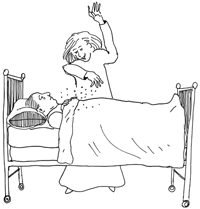STRANGEBUTTRUE- Miracle healing: It happens-- even when it doesn't

DRAWING BY DEBORAH DERR McCLINTOCK
Q. How might you become a "miracle healer" in just a few easy steps? –B. Graham
A. To start off, most diseases or conditions eventually improve by themselves or reach a certain point and become stable, says Temple University's John Allen Paulos in Innumeracy. So whatever treatment you suggest (incantations, goat entrails burned under a full moon, etc.) will often seem at least partially successful. In many cases, the ubiquitous placebo effect will also work in your favor: People want to get better, so they'll readily imagine they're feeling better thanks to your treatment.
What the above doesn't take care of, memory selectivity might. Your successes will tend to stand out, and make the rounds by word of mouth; failures will soon be forgotten and buried. "Chance provides more than enough variation to account for the sprinkling of successes that will occur with almost any treatment; indeed, it would be a miracle if there weren't any 'miracle cures,'" Paulos writes.
Q. There's no barn alongside a certain road, but you want to put one there– in a witness's memory. Got the trick? –C. Nolan
A. Use leading questions, a technique well known to courtroom practitioners.
Memory expert Elizabeth Loftus showed test subjects a film of an auto accident, then asked half of them, "How fast was the white sports car going when it passed the barn while traveling along the country road?" and the other half, "How fast was the white sports car traveling along the country road?" A week later she asked all the viewers if they had seen a barn. Actually, there had been no barn in the film.
Now a good percentage of the "witnesses" who had heard mention of a barn stated they had seen one, compared to almost none of the others.
Also, cars can be speeded up and broken glass conjured with calculated phrasings: In another study, subjects viewed a film clip of an accident and now half were asked, "How fast were the cars going when they 'hit' each other?" and the rest, "How fast were the cars going when they 'smashed into' each other?" Those hearing "smashed into" judged that the cars had been going faster, and many later were even willing to agree that there had been broken glass when there in fact was none.
Moral: Memory is malleable as well as slippery.
Q. To relieve tension during human body dissections, med students often nickname the cadaver and tell apocryphal tales. Can you imagine some of the names and yarns? –V. Frankenstein
A. Common ones are Abber Cadaver, Kay Daver, Ernest (so you can be "working in Ernest"), Stumpy (one-legged cadaver) and Anne Nomoly (anomaly), says Kenneth V. Iserson in Death to Dust: What Happens to Dead Bodies?
Recurring dissection stories, akin to urban legends, have students doing the following: 1. Carting off body parts and using them to shock "civilians," such as by extending a dead hand to give a bus driver money. 2. Manipulating a cadaver's private parts to get a rise out of other students. 3. Eating part of the body. 4. Dressing a cadaver to make it appear to have come back to life. 5. Discovering in horror that the cadaver (whose face is usually covered during much of the procedure) is a recently dead relative.
~
Send Strange questions to brothers Bill and Rich at [email protected]
#